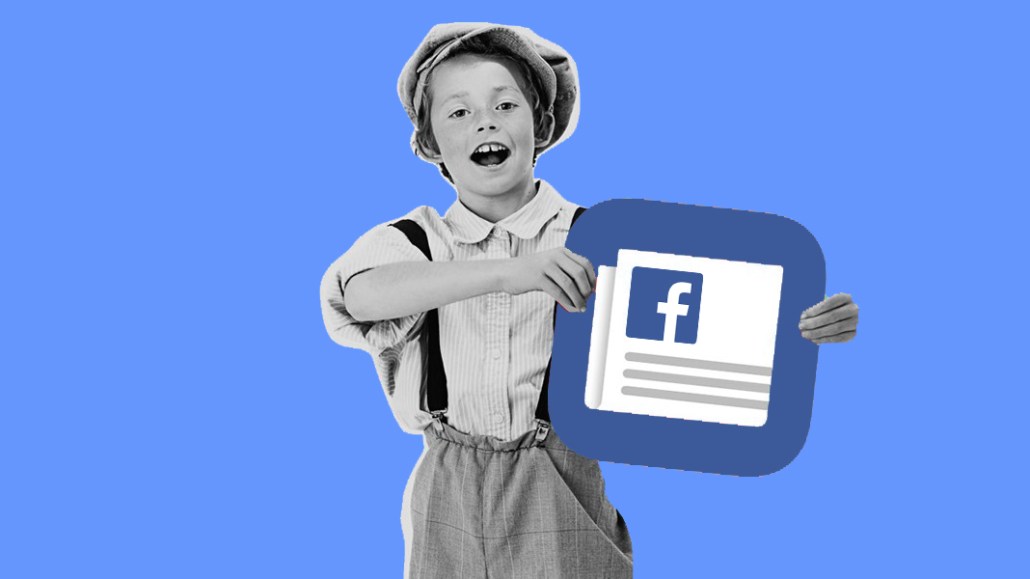Facebook’s working with publishers on paid subscriptions

Facebook is working on plans to let people pay to subscribe to publications through its app by year-end, according to publishers.
Publishers have lobbied Facebook for this since the platform introduced its fast-loading Instant Articles two years ago. Instant Articles was designed to keep people in the app, rather than clicking through to the publisher’s site, where the publisher could offer them subscriptions.
There are a lot of details to be worked out, including what the model would look like, what subscriber data publishers would get and how the revenue would be distributed. Facebook has moved toward a metered model, and while nothing is final, the latest proposal involves a metered model where users could read up to 10 articles for free a month before being required to subscribe. Publishers would be able to decide if each article is subject to that meter, free or behind a hard paywall, according to people familiar with the discussions.
“They are acknowledging that a paid subscriptions model is a viable business model and the value of high quality journalism is important and something that people and are paying for,” said Karl Wells, gm of WSJ Membership at The Wall Street Journal, which reported on the plans last week.
A Facebook spokesperson described its efforts with the following statement: “We’re working with partners to understand their business and explore ways we can help them drive more value from Facebook. We are taking the time to deeply understand their different goals and needs.”
Facebook seems interested in giving publishers more than one option. Initially, it proposed letting users pay one price for access to all publications, like the Netflix model. That raised questions about how publishers would be paid, whether based on time users spend with the publication or the publication’s subscription price. Facebook subsequently proposed a metered model, first with a 20-article limit, then 10. Still, one concern is that publishers wouldn’t be able to tailor offers based on a user’s reading history, as they can on their own site.
“The key is, how much will they constrain us?” a publisher wondered.
Other questions still remain around how payment would work. If the subscriptions are sold through Instant Articles, which is under discussion, it could cause publishers such as The New York Times that have been holdouts or bailed on the feature to reconsider using it. One way subs could be sold is through Google Play or the Apple App Store, which take a 30 percent cut of digital products sold through them. It’s unclear if Facebook would take a cut on top of that. Another way is for publishers to implement paywalls and subscription models on the mobile web through Facebook. In this scenario, users of Facebook’s mobile app can click through to Facebook’s in-app browser and can then log in to their subscription account with that publisher.
Another issue is how much subscriber data publishers would be able to collect from transactions, which they need to understand why people subscribe. One proposal that’s been discussed would let users buy more than one publication at once at a discount, which raises the question of whether the publisher would forego access to subscriber data if the user is buying publications from multiple titles at once.
“We’d want to hold on to the billing relationship and the first-party data that comes with that,” Wells said. “The goal of a subscription business is to get more and more personalized. Without that you become a one-size-fits-all machine.”
Facebook’s movement in this area stands in contrast to Google, which paywalled publishers say unfairly punishes them by dinging them in search results unless they allow their content to be read for free through Google search. The Journal stopped doing that in February to protect its subscription revenue and saw its traffic from Google News traffic plunge 94 percent in May versus a year ago.
Publishers from Journal parent News Corp to the Financial Times are urging Google to revisit First Click Free. “Google literally punishes the premium,” said News Corp chief Robert Thomson in a recent speech, adding the platform does this with what he called its “blatant abuse of its search monopoly.” Google in 2015 amended the policy to appease paywalled publishers, but there’s no sign that Google plans to revisit it again.
A third platform, Apple News, has won favor with publishers when it created a subscription option last year, which helped make up for the fact that Apple News had no other way for publishers to make money off the platform. But Apple News only has one subscription option available, and the app is less important in terms of publisher referral traffic. Apple hasn’t replied yet to requests for comment.
More in Media

BuzzFeed’s sale of First We Feast seen as a ‘good sign’ for the M&A media market
Investor analysts are describing BuzzFeed’s sale of First We Feast for $82.5 million as a good sign for the media M&A market — which itself is an indication of how ugly that market had become.

Media Briefing: Efforts to diversify workforces stall for some publishers
A third of the nine publishers that have released workforce demographic reports in the past year haven’t moved the needle on the overall diversity of their companies, according to the annual reports that are tracked by Digiday.

Creators are left wanting more from Spotify’s push to video
The streaming service will have to step up certain features in order to shift people toward video podcasts on its app.








